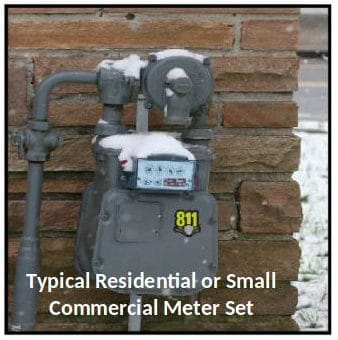
We all had schoolteachers who told us to “remember this; you’ll need it someday.” Calculating a natural gas bill is proof positive that the math and science teachers were right. Here is a general overview of how it is done for a residential customer. Some other factors impact business and industrial rate classes, but for now, let’s keep it “simple.”
1. Calculate the BTU Factor
The heating value of natural gas (“calorific value” or “heat content”) is the primary measure of its ability to perform a heating service and a critical factor in its purchase and sale. The heat values of natural gas can vary based on several factors.
This heating value is expressed in British Thermal Units (BTU) per cubic foot of natural gas, and it is called the “BTU factor.” A Gas Chromatograph is used by those who sell and transport natural gas to MTNG to measure the BTU factor. The numbers they provide are averaged for use during the billing period. Natural gas is sold to end-use customers on a “Therm (Th)” basis (100,000 BTUs = 1 Therm). MTNG’s BTU factor ranges from 1.030 to 1.090 Th/CCF. Its average value is around 1.065 Th/CCF. A higher BTU factor results in fewer cubic feet of natural gas required to produce a given amount of heat; a lower BTU factor results in more cubic feet of natural gas required to produce the same amount of heat. Now, hold on to that piece of the equation, and let’s look at the others.
2. Measure the Natural Gas Accurately
Your natural gas meter measures the volume of natural gas that passes through it to your home. It is usually expressed on residential meter indexes in one hundred cubic feet or CCF increments. However, unlike solids and liquids, the amount of a gas in a given volume can vary greatly depending on two other factors, pressure and temperature. MTNG must control or account for these two other factors to bill fairly year-round.

- The pressure is controlled by the regulators on the system. The meter regulators are set at a known rate called the pressure factor.
- Temperature is accounted for in our measurements because most meters are temperature compensated. That means they self-adjust to account for fluctuations due to temperature changes.
As a result, the amount of potential heat in the measured volume of gas becomes standardized by controlling the variables. Are science classes coming back to you now? Are you remembering Boyle, Mariotte, Charles, Gay, Lussac, and Avagadro? Good. Next comes the math part.
3. Do the Math
So, now that we have accounted for the variables, we can accurately measure the natural gas volume (CCF) with your natural gas meter. An MTNG meter reader collects a monthly reading from each customer’s meter and records the reading as the number of “hundred cubic feet” (CCF) that passed through the meter. The meter reader typically utilizes electronic technology that may not require access to your property, saving our customers money by keeping our costs low. As a safety and billing double-check, each meter is also physically checked at regular intervals. The previous month’s reading is subtracted from the current month’s reading, and the resulting number is your natural gas usage for the month. That usage is multiplied by the BTU factor to establish how many Therms were used during that monthly billing cycle.
Monthly usage (CCF) x BTU factor(1.069 Th/CCF currently) = Therms used
The number of therms you received from us that month is then multiplied by the “Rate” charged for your particular type of service (residential, business, large industry, etc.). Like most utilities, MTNG adds a monthly customer charge to the bill. This charge is often called the “minimum bill” because it is the amount you will pay each month even if you have ZERO usage. MTNG keeps our minimum bill as low as possible. Our residential customer charge is currently only $9 per month.
(Therms x Rate) + Monthly Customer Charge = Amount Due
These variables and adjustments are why you may get different “costs per therm” if you compare monthly bills by dividing the amount you owe by the amount you used each month. We do the science and math to make sure you pay a fair price and ONLY pay for the energy we deliver. We hope this helped you and made our teachers proud.
4. Compare Costs
Now that you know how to calculate your bill suppose you want to see how natural gas stacks up against other energy sources. In that case, you may use this Fuel Cost Comparison to compare the relative prices of Natural Gas, Electricity, Propane, Kerosene, and Coal for the same amount of energy delivered. The document also compares the annual operating costs of typical household appliances for Natural Gas and Electricity.

